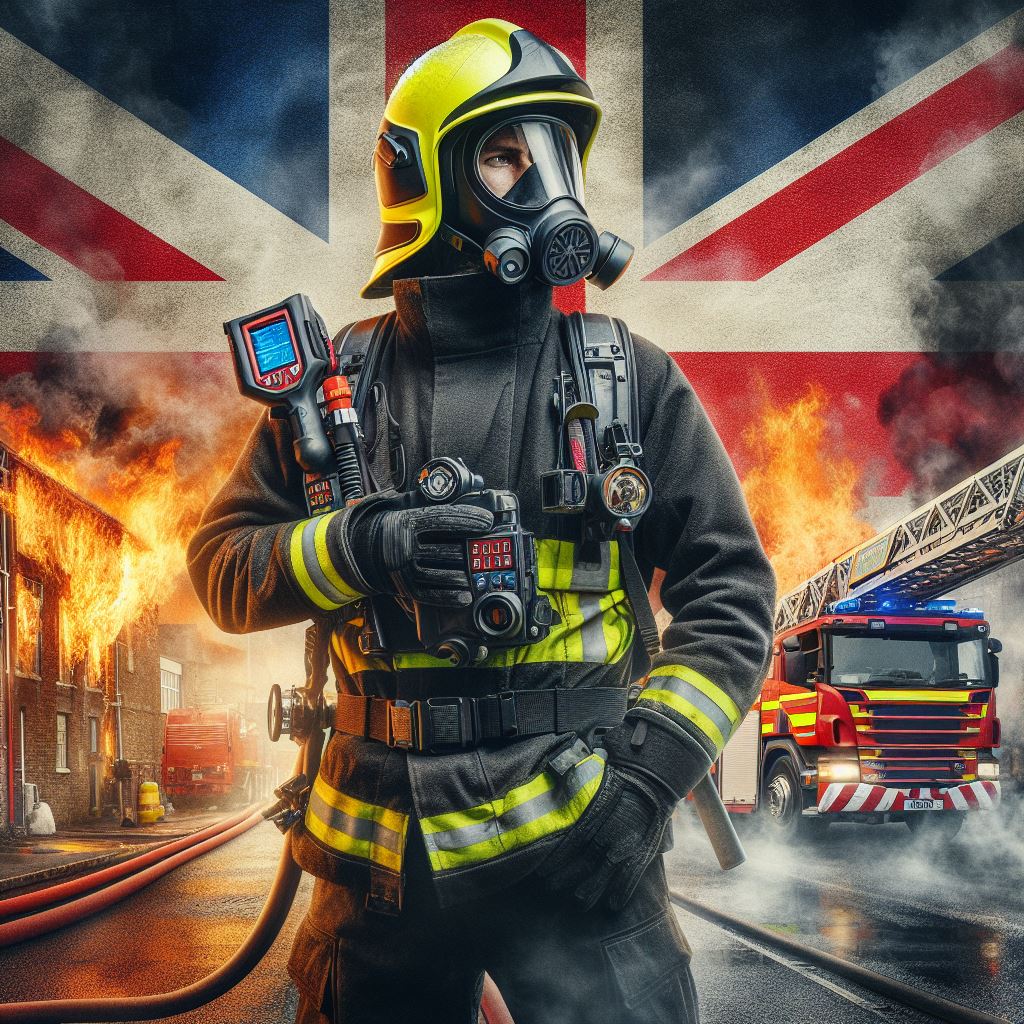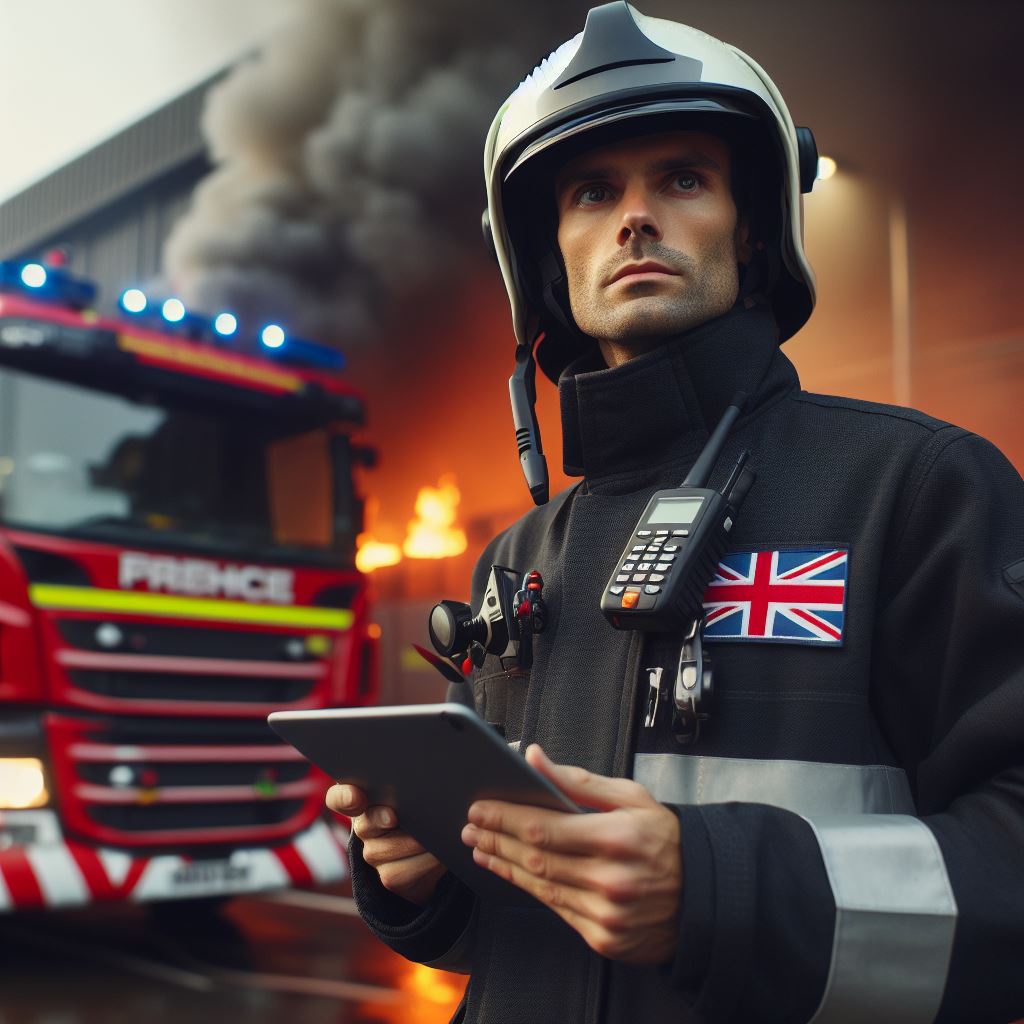Introduction
Firefighting plays a vital role in society as it ensures public safety and protects lives and property from fire hazards.
In the United Kingdom, firefighters serve as the first line of defense, responding to emergencies, conducting rescues, and providing fire prevention education.
Firefighters in the United Kingdom are highly trained professionals who are available 24/7 to tackle various emergencies.
They not only fight fires but also respond to incidents such as road traffic accidents, hazardous material spills, and natural disasters.
These brave individuals undergo rigorous training and acquire specialized skills to handle complex situations efficiently.
They work as part of a team, using advanced equipment and technology to protect and save lives.
The role of firefighters goes beyond extinguishing fires; they play a crucial role in educating the public about fire safety measures.
They conduct fire safety inspections, promote awareness campaigns, and provide guidance on emergency evacuation plans.
Furthermore, firefighters are often at the forefront during community events, organizing fire safety demonstrations and engaging with the public to promote fire prevention and safety.
In recent years, the firefighting landscape has evolved due to advancements in technology and changing societal needs.
Firefighters now face new challenges, such as tackling high-rise fires and natural disasters intensified by climate change.
To adapt to these changes, the future of firefighting in the United Kingdom will require ongoing training and investment in modern equipment.
Collaboration with other emergency services and continuous research and development are also crucial to ensure effective and efficient firefighting operations.
Generally, firefighting is a vital profession that safeguards society by responding to emergencies, educating the public, and preventing fire hazards.
The role of firefighters in the United Kingdom is indispensable, and their constant evolution and adaptation will shape the future of firefighting in the country.
Personalized UK Career Consulting
Receive tailored career guidance designed just for you. Get actionable steps and expert support to boost your career in 1-3 days. Take control of your career now.
Get StartedEvolution of Firefighting
A. The historical background of firefighting in the UK
- The historical background of firefighting in the UK dates back to ancient times.
- In pre-industrial Britain, fire brigades were run by individuals and private companies.
- The Great Fire of London in 1666 led to the establishment of the first organized and paid fire service.
B. How firefighting techniques, equipment, and training have evolved over time
- Firefighting techniques initially involved manual labor, using buckets, hooks, and water pumps.
- The 18th century saw the introduction of fire engines, equipped with hand-operated pumps.
- The development of fire hydrants in the early 19th century significantly improved firefighting capabilities.
- In the mid-19th century, steam-powered fire engines emerged, allowing quicker and more effective response.
- The creation of municipal fire brigades in the late 19th century standardized firefighting across the UK.
- The introduction of motorized fire engines in the early 20th century revolutionized fire services.
- World War II brought new challenges, as firefighters faced aerial bombing and incendiary attacks.
- Firefighting training evolved to include specialized courses, improving firefighters’ knowledge and skills.
- The late 20th century witnessed advancements in firefighting equipment, such as self-contained breathing apparatus.
C. Major milestones and advancements in firefighting technology
- Major milestones in firefighting technology include the introduction of thermal imaging cameras for better visibility.
- Automatic sprinkler systems became common in buildings, significantly reducing fire-related casualties.
- The use of foam and chemical agents revolutionized the suppression of hazardous material fires.
- The introduction of advanced communication systems allowed for better coordination during emergencies.
- Modern firefighting focuses on prevention, risk assessment, and community fire safety programs.
- Firefighters now receive extensive training in hazardous materials response and urban search and rescue.
- Fire departments collaborate with other emergency services to improve disaster response efficiency.
- The adoption of cutting-edge technology, such as drones, aids in quick assessment and firefighting operations.
- Firefighting in the future may see the utilization of robotics and artificial intelligence for enhanced safety.
- Ongoing research aims to develop more efficient firefighting agents and equipment.
- Climate change poses new challenges, such as increased wildfire risks, requiring adaptive strategies.
- Collaborations with international firefighting agencies allow for knowledge sharing and improved techniques.
The future of firefighting in the UK rests on continuous innovation, training, and adapting to emerging threats.
Read: Fire Safety Education: A UK Firefighter’s Role
Challenges Faced by Firefighters
A. Key Challenges Faced by Firefighters in the UK
- Limited resources and funding hamper the ability to respond effectively to emergencies.
- High population density and urbanization increase the frequency and complexity of emergencies.
- The rise in high-rise buildings presents unique challenges for firefighting operations.
- Inadequate public awareness and fire safety education contribute to preventable emergencies.
B. Impact of Climate Change on Firefighting Operations
- Climate change leads to more frequent and intense extreme weather events, such as heatwaves and storms.
- Increased temperatures and drought conditions raise the risk of wildfires across the UK.
- Rising sea levels pose a threat to coastal regions, requiring specialized training and equipment for water rescues.
- Climate change exacerbates existing challenges by stretching resources and personnel during emergencies.
C. Increasing Complexity of Emergencies and the Need for Specialized Skills
- Technological advancements and evolving hazards require firefighters to constantly update their skills and knowledge.
- Emergencies involving hazardous materials demand specialized training and equipment to ensure safe containment and mitigation.
- Medical emergencies, including cardiac arrests, often require immediate response from firefighters with medical training.
- Collaborative efforts and coordination with other emergency responders become crucial in handling complex incidents.
Overall, firefighters in the UK face numerous challenges as they strive to protect lives and property.
Limited resources and funding, coupled with the impact of climate change and increasing complexity of emergencies, create a demanding environment for firefighting operations.
It is essential to prioritize adequate funding, continuous training, public education, and collaborative approaches to address these challenges effectively.
By recognizing the evolving needs of firefighters and providing the necessary support, we can ensure a safer future for both firefighters and communities they serve.
Read: Women in UK Firefighting: Breaking Barriers
Technological Advances in Firefighting
In recent years, technological advancements have significantly transformed the field of firefighting.
New tools and equipment have revolutionized the way firefighters combat fires and improve overall safety.
A. Latest technologies used in firefighting
Here, we explore some of the latest technologies used in firefighting and their importance in enhancing efficiency and effectiveness.
1. Thermal Imaging Cameras
- Thermal imaging cameras have become a crucial tool for firefighters in identifying hotspots and locating trapped individuals.
- These cameras can detect heat signatures, allowing firefighters to navigate through dense smoke and darkness.
- By visualizing temperature variations, thermal imaging cameras aid in making informed decisions during rescue operations.
2. Drones
- Drones equipped with high-resolution cameras provide an aerial perspective of fire incidents, aiding in situational awareness.
- They can quickly survey large areas, determining the spread and intensity of fires.
- Moreover, drones can deliver essential supplies to firefighters and are also used for search and rescue missions.
3. Advanced Protective Gear
- Modern firefighting gear is designed with advanced materials that offer increased protection against heat and hazardous substances.
- These suits have integrated breathing apparatus, enabling firefighters to breathe in smoke-filled environments.
- Improved gear also enhances mobility and endurance, allowing firefighters to work for longer periods without discomfort.
4. Communications Systems
- Efficient communication plays a vital role in coordinating firefighting efforts.
- New communication systems enable seamless interaction between firefighters and incident commanders.
- Integrated voice and data systems improve coordination, ensuring timely and accurate information sharing.
5. Robotics and Artificial Intelligence
- Robots are increasingly being employed in firefighting operations, especially in hazardous environments.
- Equipped with sensors and cameras, robots can access areas that are inaccessible or too risky for human firefighters.
- Artificial intelligence assists in analyzing data from sensors, facilitating decision-making and alerting firefighters of potential hazards.
6. Predictive Analytics
- Predictive analytics software uses historical data and real-time information to forecast fire behavior and spread.
- This technology helps firefighters anticipate potential developments, enabling them to allocate resources effectively.
- By combining data on weather conditions, building materials, and geographical factors, predictions become more accurate.
7. Virtual Reality Training
- Virtual reality (VR) training allows firefighters to simulate emergency scenarios in a safe and controlled environment.
- Immersive VR experiences help enhance decision-making, problem-solving, and teamwork skills.
- Firefighters can practice techniques, procedures, and situational responses to improve their overall preparedness.
In short, technological advances have revolutionized the field of firefighting, equipping firefighters with tools that enhance efficiency and effectiveness.
The integration of thermal imaging cameras, drones, advanced protective gear, and communication systems has significantly improved the safety of both firefighters and those they rescue.
Moreover, robots, artificial intelligence, predictive analytics, and virtual reality training continue to push the boundaries of firefighting capabilities.
As technology continues to evolve, firefighting agencies must stay updated and adapt to these innovations, ensuring the best possible response to fire incidents and safeguarding lives and property.
Your Dream Job Starts with a Perfect CV
Get a tailored CV and cover letter that captures your unique strengths and stands out in your industry. Let us help you make an unforgettable first impression.
Get StartedRead: Understanding the UK’s Fire Service Ranks

Integration of Artificial Intelligence
Artificial Intelligence (AI) has the potential to revolutionize firefighting in the United Kingdom.
With its advanced capabilities, AI can significantly enhance fire prediction, prevention, and early detection techniques.
However, there are also concerns and limitations that need to be addressed before full integration can be realized.
A. The Potential Role of AI in Firefighting
AI can play a crucial role in firefighting operations by analyzing vast amounts of data and providing valuable insights.
By leveraging machine learning algorithms, AI can effectively process information from various sources such as weather patterns, building designs, and historical fire incidents.
This enables firefighters to make more informed decisions and develop proactive strategies.
B. How AI can assist in fire prediction, prevention, and early detection
1. AI for Fire Prediction
One of the key benefits of AI in firefighting is its ability to predict fires before they occur.
By analyzing data patterns and identifying potential hazards, AI algorithms can highlight areas that are at higher risk of fire outbreaks.
This allows authorities to allocate resources efficiently and implement preventive measures to minimize the likelihood of fires.
2. AI for Fire Prevention
AI can also assist in fire prevention efforts by monitoring and controlling potential fire hazards.
For example, smart sensors equipped with AI can detect smoke, heat, or other indicators of fire and immediately raise alarms.
This enables quick responses and minimizes the risk of fire spreading, leading to reduced damage and increased safety for both civilians and firefighters.
3. AI for Early Detection
Early detection of fires is crucial for timely response and minimizing the damage caused.
Optimize Your LinkedIn for Success
Boost your LinkedIn profile with a professional bio, keyword-rich headline, and strategic recommendations that attract recruiters. Stand out from the crowd and get noticed.
Optimize NowAI-powered systems can analyze real-time data from different sources like surveillance cameras and smoke detectors to instantly identify fire incidents.
This can significantly reduce response times and improve the efficiency of firefighting operations.
C. Addressing Concerns and Limitations
While the integration of AI in firefighting holds immense potential, there are important concerns that need to be addressed.
- One major concern is the reliability and accuracy of AI algorithms. The system must be thoroughly tested and constantly updated to ensure its effectiveness in different scenarios.
- Another concern is the ethical use of AI. Privacy and security issues arise when AI systems involve extensive data collection.
- Safeguards must be implemented to protect personal information and ensure compliance with relevant regulations.
- Furthermore, there is a need for extensive training and education of firefighters to effectively use AI technologies.
- This includes familiarizing them with AI systems and teaching them how to interpret and act upon the insights generated by these systems.
In essence, the integration of AI in firefighting operations has the potential to revolutionize the future of firefighting in the United Kingdom.
It can enhance fire prediction, prevention, and early detection techniques, ultimately improving the safety of civilians and firefighters alike.
However, concerns regarding reliability, ethics, and adequate training must be addressed before widespread adoption can occur.
With proper planning and implementation, AI can be a game-changer in the fight against fires.
Training and Education for the Future
A. Continuous training and education in the firefighting profession
In the fast-paced and ever-evolving world of firefighting, it is crucial to acknowledge the need for continuous training and education.
Firefighters must be equipped with the latest knowledge and skills to effectively combat fires and save lives.
B. Incorporating emerging technologies and techniques into training programs
Emerging technologies and techniques have the potential to revolutionize the firefighting profession.
Incorporating these advancements into training programs is essential to ensure that firefighters are up to date with the latest practices.
This can include virtual reality simulations, robotic systems, and advanced firefighting equipment.
Training programs that integrate emerging technologies can provide firefighters with realistic and immersive experiences.
They can simulate various fire scenarios, allowing firefighters to practice their skills in a safe and controlled environment.
These programs can also help improve decision-making abilities, response times, and overall efficiency.
C. The role of professional development in preparing firefighters for future challenges
The role of professional development cannot be overstated when it comes to preparing firefighters for future challenges.
- Firefighters should be encouraged to pursue continuous learning opportunities, attend seminars, and workshops.
- These activities not only enhance their skills but also broaden their perspectives and expose them to new ideas.
- Professional development can include specialized training in areas such as hazardous material handling, technical rescue, and incident command.
- By acquiring additional certifications and qualifications, firefighters can expand their expertise and become valuable assets to their departments.
- Moreover, professional development fosters a culture of constant improvement and personal growth within the firefighting profession.
- Firefighters who actively seek out learning opportunities are more likely to embrace change and adapt to new technologies and techniques.
- Additionally, professional development initiatives should extend beyond technical skills.
- Firefighters should be encouraged to develop essential soft skills such as leadership, communication, and teamwork.
- These skills are vital for effective coordination during emergency situations and can contribute to a safer and more efficient firefighting operation.
- Collaboration between firefighting agencies and educational institutions is crucial to ensure that training programs are tailored to meet the future needs of firefighters.
- By actively involving industry experts and academia, training programs can be designed to address emerging challenges and foster innovation.
Basically, continuous training and education, incorporation of emerging technologies, and professional development are essential components for the future of firefighting in the United Kingdom.
By investing in these areas, firefighters can stay ahead of the curve and effectively respond to the evolving demands of their profession.
Collaboration and Community Engagement
A. Importance of community engagement in firefighting efforts
- Community engagement is a crucial aspect of firefighting efforts as it brings about several benefits and strengthens the overall firefighting system.
- Community engagement fosters a sense of responsibility and ownership among community members towards fire safety.
- People become more aware of their role in preventing fires and supporting firefighters during emergency situations.
- Community engagement facilitates open communication channels between firefighters and community members.
- Firefighters can effectively convey important safety messages and gather feedback on community concerns.
- Collaboration between firefighters, communities, and emergency services creates a support system during fire incidents.
- Communities play an active role by providing information, resources, and assistance to firefighters during emergencies.
- Engaging with diverse communities ensures that fire safety measures are tailored to their specific needs and cultural practices.
B. Successful collaboration between firefighters, communities, and other emergency services
- Successful collaboration between firefighters, communities, and other emergency services is essential for effective firefighting.
- Collaboration enhances the emergency response system, ensuring prompt and efficient actions during fire incidents.
- Firefighters work closely with communities and educate them about fire safety measures and prevention strategies.
- Collaboration between firefighters, communities, and emergency services creates a support system during fire incidents.
- Collaboration helps to identify high-risk areas and implement targeted fire prevention strategies.
- Firefighters collaborate with community leaders, local authorities, and organizations to raise funds for fire safety initiatives.
- This collaboration ensures that necessary resources are available for firefighting efforts and community education programs.
- Collaboration enables the sharing of resources, knowledge, and best practices among different emergency services.
- This sharing of expertise enhances the overall effectiveness of emergency responses and firefighting operations.
- During major fire incidents, collaboration ensures a coordinated approach among multiple agencies and services.
- Firefighters collaborate with police, medical services, and other emergency responders to provide a comprehensive response
C. Benefits of proactive fire prevention programs and public awareness campaigns
- Proactive fire prevention programs play a vital role in reducing the occurrence of fire incidents.
- Public awareness campaigns are conducted to educate the community about fire hazards and the importance of preventive measures.
- By engaging with the community, firefighters gain vital insights into local fire risks and vulnerabilities.
- The involvement of communities in fire prevention measures creates a collective responsibility towards public safety.
- Through collaboration, firefighters and communities build trust and establish strong networks, contributing to efficient firefighting.
- Collaboration also strengthens the overall resilience of communities in facing fire incidents and other emergencies.
- Collaboration between firefighters, communities, and emergency services creates a support system during fire incidents.
- Collaboration and community engagement contribute to a fire-safe environment and a proactive firefighting approach.
- By working together, firefighters, communities, and emergency services can effectively prevent and respond to fire incidents.
The future of firefighting in the United Kingdom relies on strong collaboration and active community engagement.
Read: Firefighter Fitness: Staying Fit for Duty in the UK
Gain More Insights: The Influence of Lobbyists on UK Politicians
Conclusion
In this blog post, we have explored the future of firefighting in the United Kingdom.
We discussed the key points that highlight the advancements in technology and training that are making firefighting more effective and efficient.
The introduction of drones, augmented reality, and improved communication systems are revolutionizing the way firefighters combat fires.
Furthermore, we highlighted the promising future of firefighting in the United Kingdom, with the government investing in research and development of new technologies.
This commitment to innovation is expected to improve response times, enhance firefighter safety, and minimize damage to properties.
Ultimately, it is important to support and appreciate the crucial role of firefighters in society.
Their dedication, bravery, and selflessness save lives and protect communities every day.
As the future of firefighting continues to evolve, it is crucial for society to extend its support and appreciation to these heroic individuals.
Let us recognize their efforts and continue to provide them with the resources they need to keep us safe.
[E-Book for Sale]
500 Cutting-Edge Tech Startup Ideas for 2024 & 2025: Innovate, Create, Dominate
$19.99 • 500 Tech Startup Ideas • 62 pages
You will get inspired with 500 innovative tech startup ideas for 2024 and 2025, complete with concise descriptions to help you kickstart your entrepreneurial journey in AI, Blockchain, IoT, Fintech, and AR/VR.




